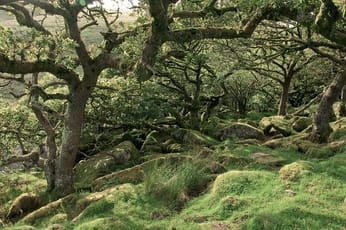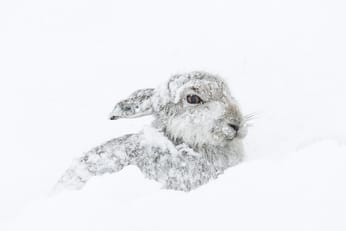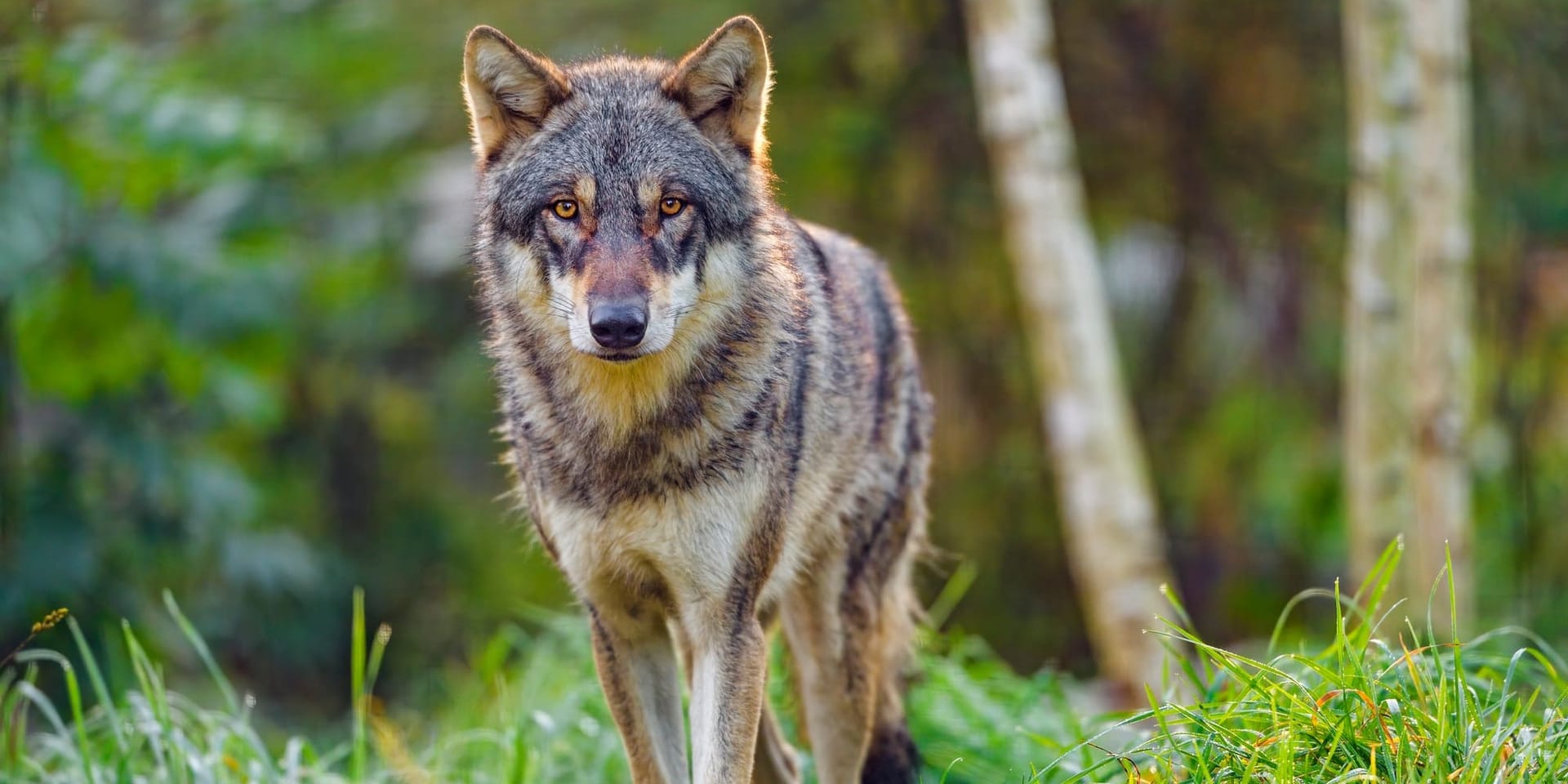
Wolf watching in the Scottish Highlands in 2044
Matthew Hay takes a trip into the future to watch wolves in the snowless Cairngorms, a decade after their reintroduction to the Highlands.
‘I’d describe myself as a deer stalker, first and foremost,’ our guide said. ‘I only do a few of these tours each year, once the hind season has finished. Whisky?’
Both my companion and I gratefully accepted a plastic mug, into which our guide poured a Highland single malt.
‘Slàinte,’ she said, and we all raised our mugs to acknowledge the toast. ‘To 2044 being a better year than the last.’
I lifted the mug to my lips to drink, but before I’d managed to take a sip, our guide hissed at us: ‘Shhh! Did you hear that?’
I hadn’t heard anything and my companion shook his head. For 30 seconds no-one spoke, and all I could hear was my heart, beating slightly harder than normal, as I squinted through the twilight.
The three of us were sat nearly 800 metres up, close to the summit of a hill called Creag a’Mhadaidh in the Cairngorms National Park. I’d grown up some 60 miles to the south, near Perth. My friend, a keen hillwalker, lived and worked in York. When we met, back at university, the idea of this trip – of what we were about to see – would have seemed impossible.
And yet, here we were.
Some 300 metres below us, a car sped along the A93. Its headlights punched holes in the gloam, while the roar of tyres on tarmac drowned out the subtle whine of its electric engine. Then, suddenly, a long, mournful cry drifted up from the glen.
I felt the hairs on my neck stand on end. I couldn’t believe it. A wolf, howling in the Scottish Highlands.
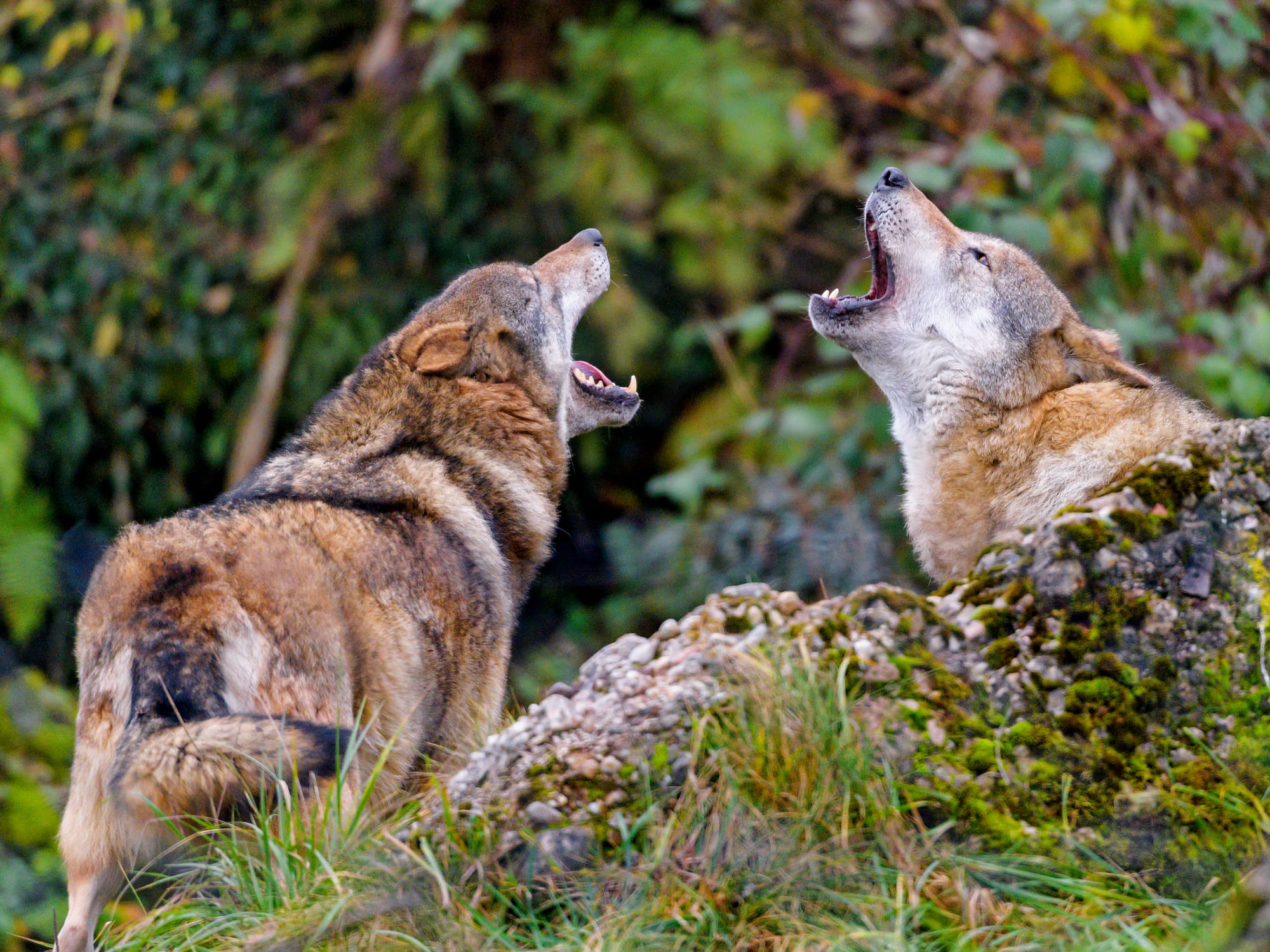
Our guide had a telescope out and was scanning the ground. The daylight was rapidly fading and our chances of spying it before nightfall were fast diminishing.
‘Where are you?’ our guide muttered to herself, one eye pressed to the scope. She lingered on scree slopes further up the glen, hoping to glimpse some movement amongst the boulders.
‘That howl sounded like Ailsa,’ she continued, apparently talking to us again. ‘And that’s bad news for you guys, I’m afraid, because she is canny.’
For the next five minutes she traced the line of the Baddoch burn with her scope. But, although we heard another howl, she was unable to locate the wolves.
‘Don’t worry,’ our guide said. ‘I’ve got one more trick up my sleeve.’ She rummaged in her coat pocket, pulling out a thermal spotter and putting it to her eye.
About five seconds passed before she said, ‘Boom! There they are. The Baddoch pack!’
Passing the spotter over to my friend, she directed him towards an old forestry plantation and told him to scan along its western edge.
‘I see them!’ he exclaimed. ‘Wow, look at them. That is so cool!’
A few seconds later, he passed the spotter over to me. Four bright white shapes were trotting along the edge of the pines. Despite their relaxed gait, they were covering the ground quickly, moving south up the glen before turning east and fording a burn.
We watched the wolves for the next ten minutes, taking it in turns to follow them with the spotter as they ascended a ridge and loped up towards the summit. Before long, they had crested the hill and dropped down onto the other side. Gone.
With broad grins plastered across our faces, we packed up our kit and walked back down by the light of our head torches, towards our guide’s pick-up. All three of us were relieved. The trip had been a success. A memorable experience and money well spent, especially for my friend, who had never seen a wolf in the wild before.
With her clients clearly satisfied, our guide began to talk more easily and openly about the wolves.
‘My Dad hates that we’ve got wolves back in Scotland,’ she began. ‘He’s pretty old school, though. Thinks there’s enough of a challenge in delivering good deer management without throwing an apex predator into the mix.
‘And…’ she added playfully, casting an obvious look towards my companion and his spotless North Face down jacket, ‘that wolves are a fad forced on us by city folk with romantic notions of how the Highlands should be.
‘I like to wind Dad up about it,’ she confessed. ‘His birthday is in April, so I always tell him I’ve bought his present with money from my spring wolf tours. He just shakes his head and says that it’s only a matter of time until someone is killed by one and then we’ll all be sorry.’

‘What has been the worst thing about having them back?’ my friend asked.
'Oh, well, that depends who you are,’ our guide replied. ‘See, if you’re a sheep farmer then you’ve had to change your whole operation. No more hefted flocks left out on the hill in all weathers. Sheep have to be shepherded now, protected with dogs and fences and all sorts. Loads of the farmers just didn’t bother making that transition. Easier to sell the flock and do something else.’
‘Wow – that’s a pretty major change,’ my friend acknowledged. ‘How did you stop the farmers just hating everything about this reintroduction?’
‘We didn’t entirely,’ our guide responded, ‘but what really helped were the MAD voles.’
‘The what?’ my friend laughed, convinced he’d misheard her.
‘MAD voles,’ our guide repeated. ‘It’s the nickname for an organisation called Volunteers for Madadh-allaidh, which is the Gaelic name for wolves. It was set up by some rewilding types in Edinburgh and gets those people that really wanted wolves back in Scotland to volunteer and help those in rural communities who are affected by their return.
‘It was such a good idea,’ she went on, ‘because it got all the Gore Tex-clad do-gooders to share the cost of having wolves back. They helped sheep farmers put up new predator-proof fencing around their corrals, raised money to train livestock guard dogs and even bought some donkeys, which are great for protecting flocks, to lend to shepherds.
‘It meant that these people shared in the farmers’ pain whenever sheep were killed. But, more importantly, it allowed all these folk from different walks of life to actually talk to one another and start to understand where the other was coming from. I reckon without the MAD voles the whole thing would have gone belly up,’ she concluded, soberly.
I nodded in agreement, quietly still amazed it hadn’t all ended in disaster. Twenty years ago I could never have imagined wolves would be reintroduced to Scotland in my lifetime, let alone in the 2040s. There had been so much resistance back then, so much tribalism and mistrust, all of it exacerbated by social media, which rendered opposing views on species reintroductions into a question of identity. I just couldn’t see how Scotland would ever break the deadlock.
‘Are you pleased it worked out, then?’ I asked our guide.
‘Yeah, I am pleased actually,’ she responded. ‘I was pretty cynical at first and it’s definitely been tough for some of the hill farmers. But the way they were managing sheep had only really existed in Scotland for two or three hundred years. And that might seem like a long time – long enough to have its own heritage and culture and everything – but, before we hunted wolves to extinction, they had been here for genuinely thousands of years.
‘We have a huge, shared history with wolves in the Highlands,’ she went on, ‘and I think it’s often been forgotten. Like the Gaelic word for January is Am Faoilleach, which literally means ‘the wolf month’ because, in midwinter, the wolves would be hungry and out on the prowl.’
‘I wish you’d told us that before,’ my friend joked. ‘We’d have booked this trip for January if we’d known that!’
The next day, my friend and I headed off early back to Perth.
It was a bright late-February day and the sun’s rays contained all the promise of the coming spring. As we drove south towards the old Glenshee ski centre, a few patches of snow were still visible on the northern aspects of the highest hills. It hadn’t snowed since the start of January, but that wasn’t unusual anymore.
Some locals hoped that, since the USA and China had both agreed at COP44 to start releasing aerosols into the stratosphere – a plan to help cool the Earth by reflecting more sunlight – the winters might start getting colder again. But any future freeze was yet to show its face. The previous year had been the planet’s warmest on record, 2.2C above the pre-industrial baseline.
As we drove up the steep bend towards the Cairnwell pass, the highest stretch of public road in Britain, my companion looked out the window at the remnant ski tows that still littered some of the slopes to our east.
‘Did they really used to ski here?’ he asked.
‘Yes!’ I responded emphatically. ‘I used to ski here every winter, when I was growing up. I loved this place… Used to sneak up for a half-day when I could get the time off work.’
‘When did it close?’ my friend enquired.
‘It’s not closed, really,’ I replied. ‘It just isn’t a ski centre anymore. It’s become a base for mountain bikers, walkers and tourists. I think the ski lifts spun for the last time in 2028 so, what’s that, 16 years ago now.’
‘Woah, woah, woah! What’s that?’ my friend shouted, pointing out of the passenger window.
I glanced across and saw a snow-white mountain hare burst out from a willow thicket and sprint uphill, its outline stark against the muddy heath, signalling its presence to both tourists and predators. Years ago, when snow still covered the mountains in winter, it would have been more or less invisible – but not anymore.
‘That’s a mountain hare,’ I told him.
‘It’s absolutely beautiful,’ my friend exclaimed. ‘What a cool little animal.’
‘I wonder what made it bolt like that?’ I asked, more to myself than to him.
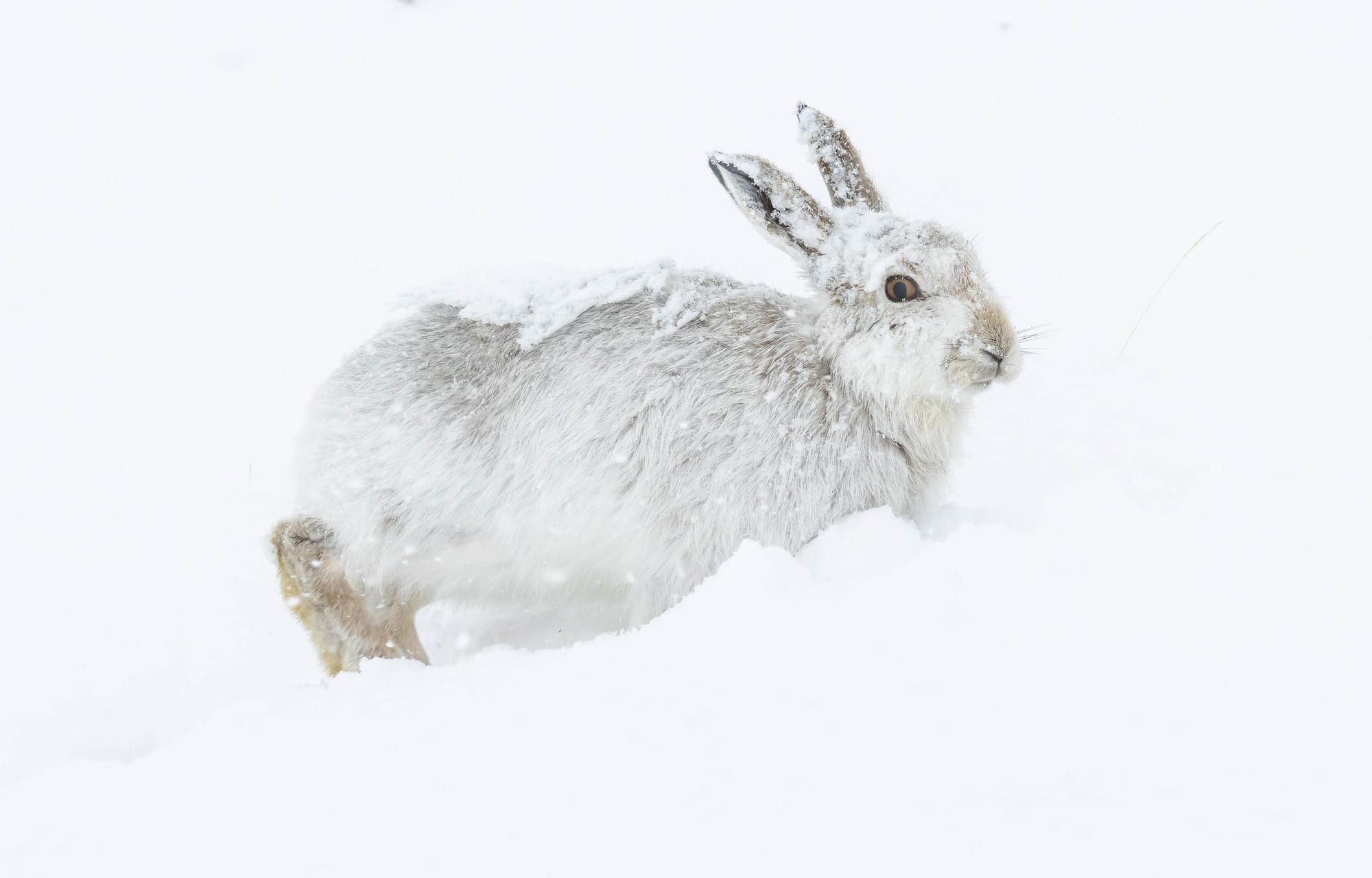
As if in answer, four wolves emerged from behind the same clump of willow, trotting neatly across the slope, seemingly oblivious – or uninterested – in the hare they had spooked.
I pulled over and put the hazard lights on, lowering the passenger window and grabbing my binoculars.
The front wolf had a radio collar around her neck. She was tall and lean, with her tail held erect to indicate her high status in the pack. She paused briefly to cast a look in our direction, holding our gaze for a couple of seconds before continuing on her way.
We watched the wolves in silence, as they shuffled away into the distance. I thought of all the effort so many people had gone to – all the stalkers, ecologists, farmers and civil servants – who had worked tirelessly to bring these animals back to the Highlands and I felt a surge of gratitude.
Climate change had robbed these hills of so much of their winter magic. I’d spent decades despairing as their cold, snowy splendour diminished. For so long, the trajectory of the world had seemed inexorably downwards: more extreme weather, more loss of nature, more uncertainty about the future.
Against this backdrop, the wolves’ return felt like a push in the other direction, like a salmon overcoming the current to leap upstream. Their repatriation had offered a brief reprieve from a narrative of endless decline. More importantly, it had reintroduced wonder to this place.
This feature was made possible by funding from The Pebble Trust.
Subscribe to our newsletter
Members receive our premium weekly digest of nature news from across Britain.
Comments
Sign in or become a Inkcap Journal member to join the conversation.
Just enter your email below to get a log in link.






